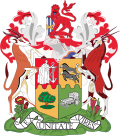| Governor-General of the Union of South Africa | |
|---|---|
| Goewerneur-generaal van die Unie van Suid-Afrika (Afrikaans) Goeverneur-generaal van de Unie van Zuid-Afrika (Dutch) | |
 | |
 | |
| Viceregal | |
| Style | His Excellency |
| Status | Abolished |
| Residence | Government House |
| Appointer | Monarch of South Africa |
| Constituting instrument | South Africa Act 1909 |
| Formation | 31 May 1910 |
| First holder | Herbert Gladstone, 1st Viscount Gladstone |
| Final holder | Charles Robberts Swart |
| Abolished | May 31, 1961 |
The governor-general of the Union of South Africa (Afrikaans : Goewerneur-generaal van Unie van Suid-Afrika; Dutch : Goeverneur-generaal van de Unie van Zuid-Afrika [a] ) was the highest state official in the Union of South Africa between 1910 and 1961. The Union of South Africa was founded as a self-governing Dominion of the British Empire in 1910 and the office of governor-general was established as the representative of the monarch of South Africa. Fifty-one years later, the country declared itself a republic and the office of governor-general was abolished. [1]
Contents
Some of the first holders of the post were members of the British royal family including Prince Arthur of Connaught between 1920 and 1924, and Alexander Cambridge, 1st Earl of Athlone, who served between 1924 and 1931, before becoming the governor general of Canada. As in other Dominions, this would change, and from 1943 onward only South Africans (in fact, only Afrikaners) held the office.
The office was established by the South Africa Act 1909. Until the Balfour Declaration of 1926 the governor-general was the representative of the British government in South Africa and was appointed by the Colonial Office in London. After the declaration and the Statute of Westminster 1931 the governor-general was appointed by the monarch on the advice of the South African government. Although the governor-general was nominally the country's chief executive, in practice he was bound by convention to act on the advice of the prime minister and the cabinet of South Africa.













